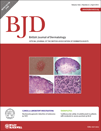Vitamin D: a novel therapeutic approach for keloid, an in vitro analysis
G.Y.Z., T.C. and Q.L. contributed equally to this work.
Funding sourcesThis work was supported in part by the following grants: the Scientific Research Fund of Zhejiang Provincial Education Department, China (Y200804988 to G.Y.Z.), the Zhejiang Provincial Natural Science Foundation of China (Y2090540 to G.Y.Z.), the Major Program of Zhejiang Extremely Key Subject for Fostering Talents (to G.Y.Z.) and the PhD Program of Shanghai Jiao Tong University (BXJ0930 to T.C.).
Conflicts of interestNone declared.
Summary
Background Vitamin D and its metabolites play an important role in calcium homeostasis, bone remodelling, hormone secretion, cell proliferation and differentiation. Recent studies also suggest a beneficial role of vitamin D in slowing the progression of tissue fibrosis. However, their effects on dermal fibrosis and keloids are unknown.
Objectives To investigate the effect of 1,25-dihydroxyvitamin D3 (1,25D) in the pathogenesis of tissue fibrosis by keloid fibroblasts (KFs).
Methods KFs were cultured and exposed to different concentrations of 1,25D in the presence or absence of transforming growth factor (TGF)-β1. KF phenotypes and protein production were analysed by real-time reverse transcriptase-polymerase chain reaction, Western blot, immunofluorescence and multiplex enzyme-linked immunosorbent assay techniques. Collagen synthesis was evaluated by measuring 3H-proline incorporation. The effect of 1,25D on cell proliferation and viability was evaluated by Formazan assay, proliferating cell nuclear antigen expression and the colorimetric conversion of 3-[4, 5-dimethylthiazol-2-yl]-2, 5-diphenyltetrazolium bromide.
Results We confirmed the presence of vitamin D receptors (VDRs) in cultured keloid fibroblasts. Fibroblasts transfected with a vitamin D response element reporter construct and exposed to the active vitamin D metabolite 1,25D showed increased promoter activity indicating VDR functionality in these cells. Incubation of KFs with 1,25D suppressed TGF-β1-induced collagen type I, fibronectin and α-smooth muscle actin expression. 1,25D also modulated plasminogen activator inhibitor-1 and matrix metalloproteinase-9 expression induced by TGF-β1. Interestingly, 1,25D induced hepatocyte growth factor mRNA expression and protein secretion in keloid fibroblasts.
Conclusions This study highlights key mechanistic pathways through which vitamin D decreases fibrosis, and provides a rationale for studies to test vitamin D supplementation as a preventive and/or early treatment strategy for keloid and related fibrotic disorders.




